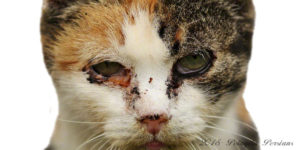Conjunctivitis Eye Infections in Cats
Symptoms

© Pelaqita Persians
The symptoms of conjunctivitis vary depending on the cause. Typically, both allergies and infections cause a severe redness or "swollen" appearance of the conjunctiva. This is caused by fluid build-up (edema) and an increase in the size and number of blood vessels within the tissue. Both allergies and infections can cause the eye to discharge or "weep". Do not confuse this with the normal eye weepage in the Persian cat breed.
The consistency of the discharge oftentimes helps to determine the cause. Usually eye infections are caused by bacteria, etc., creating a thick yellow or greenish eye discharge. The eyelids may stick together. This results from the accumulation of 'pus' (white blood cells) excreted into the area in an effort to fight the infection. On the other hand, allergies generally cause a clear or watery discharge. No matter the cause, a cat with conjunctivitis will often squint and/or keep the third eyelid partially closed. Conjunctivitis is often painful causing a cat to paw at or rub the eye against objects such as your leg or the carpet.
Risks of Eye Infections or Conjunctivitis
In general, conjunctivitis and eye infections are not life threatening. However, in advanced cases, the organisms can spread and affect other structures of the eye and can also spread to other cats in the household (allergies are not contagious and do not pose a threat to other cats). Vision could become impaired. In addition, eye infections or foreign bodies may cause corneal ulcers which are extremely serious. Conjunctivitis may be a symptom of a more serious disease such as FIV (feline immunodeficiency virus).
Treatment of Eye Infections and Conjunctivitis
Conjunctivitis should always be treated at once. A veterinarian may deem it necessary to do a culture and sensitivity test to determine if bacteria are the cause, and if so, what medication should be used for treatment (such as Terramycin or a neopolybac). Scrapings of the conjunctiva can be made and examined to test for various viral infections.
Eye drops or ointments (i.e., Terramycin or neopolybac) are usually what is prescribed. Eye drops are watery solutions that must be applied every few hours, while the ointments last longer and are usually applied 2 to 3 times per day.
If an allergy is suspected, then various medications are available containing anti-inflammatories, usually hydrocortisones. In severe cases, oral antibiotics are used in addition to the topical treatments. Most cases respond to treatment, but it may take one to two weeks to fully recover. In general, treatment is continued for several days after the eye regains its normal appearance.
WARNING
Never use an ointment that contains hydrocortisone agents if there is a corneal ulcer or scratch present. Hydrocortisone, although great at minimizing eye inflammation, can actually hinder the healing, or worsen, an ulcerated cornea. Always consult your veterinarian before using an ointment containing a hydrocortisone agent.
